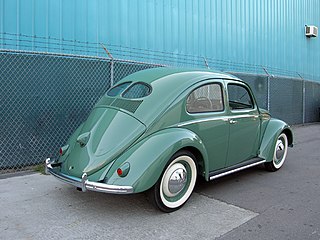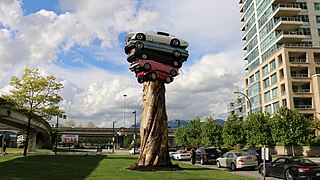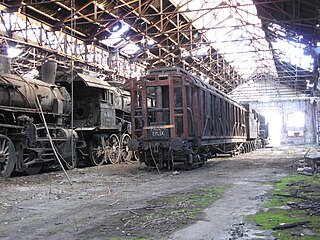

An automobile graveyard or car cemetery is a place in which decrepit road vehicles reside while waiting to be destroyed or recycled or are left abandoned and decaying.


An automobile graveyard or car cemetery is a place in which decrepit road vehicles reside while waiting to be destroyed or recycled or are left abandoned and decaying.
There are numerous automobile graveyards that can be found around the world. The purpose of each location varies. Just outside Victorville, California there are hundreds of thousands of cars that were bought back by Volkswagen after the 2015 emissions scandal and they are awaiting recycling or destruction. [1] Some cemeteries operate in a manner similar to scrapyards where rare spare parts can be found. The Historischer Autofriedhof Gürbetal in Kaufdorf comprised hundreds of cars, mostly from the 1930s to 1960s. The cars went untouched for more than 30 years. They were collected with the hope of salvaging useful and rare parts. However, time and nature led to the vehicles' decay. Overgrown with rare flora and fauna, the site had to be cleared when environmental concerns were raised in 2009. [2]
Sites containing such cemeteries can become public attractions. In the U.S. state of Georgia, Wade Alonso's Auto Parts & Wrecker Service is colloquially known as "The School Bus Graveyard". Looking for a way to reduce theft from his property, Alonso built a large wall using school buses and RVs. Many of the state's artists came to paint the sides of the buses, creating a colourful and unusual art gallery around which people are freely welcome to wander. [3] Also in Georgia is Old Car City USA, world's largest car junkyard, a site which began in 1931 as a car dealership but now serves as a 6-mile trail for visitors to discover over 4,000 cars. [4] While many automobile graveyards are easily accessible, others are much less welcoming. In 2016 urban explorers found a "mountain of vehicles" in an abandoned Welsh mine. The cars were piled up at the bottom of the slate mine and are believed to have been there since the 1970s. [5] Such sites can also be popular amongst photographers.
Some automobile cemeteries do not contain civilian vehicles such as cars and motorbikes, but specialized vehicles instead. French authorities set up a warehouse to help preserve firefighting history, storing fire engines that date back to the early 20th century. The vehicles, though covered in dust, were protected from the elements, but after an urban explorer published photographs of the site they were all moved to a new, secret location. [6] There are also sites with numerous armoured vehicles, sometimes referred to as a tank graveyard. Another notable specialized vehicles graveyard is the race car graveyard located in North Carolina owned by NASCAR driver Dale Earnhardt Jr., which became the final resting place for cars such as Juan Pablo Montoya's 2012 Daytona 500 car that collided with a jet dryer during the race. [7]

SAIC Motor Corp., Ltd. is a Chinese state-owned automobile manufacturer headquartered in Anting, Shanghai. Founded in 1955, it is currently the largest of the “Big Four” state-owned car manufacturers of China, namely: SAIC Motor, FAW Group, Dongfeng Motor Corporation, and Changan Automobile, with car sales of 5.37 million, 3.50 million, 3.28 million and 2.30 million in 2021 respectively.

Scrap consists of recyclable materials left over from product manufacturing and consumption, such as parts of vehicles, building supplies, and surplus materials. Unlike waste, scrap has monetary value, especially recovered metals, and non-metallic materials are also recovered for recycling.

A knock-down kit is a collection of parts required to assemble a product. The parts are typically manufactured in one country or region, then exported to another country or region for final assembly.

A wrecking yard, scrapyard or junkyard is the location of a business in dismantling where wrecked or decommissioned vehicles are brought, their usable parts are sold for use in operating vehicles, while the unusable metal parts, known as scrap metal parts, are sold to metal-recycling companies. Other terms include wreck yard, wrecker's yard, salvage yard, breaker's yard, dismantler and scrapheap. In the United Kingdom, car salvage yards are known as car breakers, while motorcycle salvage yards are known as bike breakers. In Australia, they are often referred to as 'Wreckers'.

FAW Group Co., Ltd. is a Chinese state-owned automobile manufacturer headquartered in Changchun, Jilin. Founded in 1953, it is currently the second largest of the “Big Four” state-owned car manufacturers of China, together with SAIC Motor, Dongfeng Motor Corporation and Changan Automobile.

The automotive industry in India is the fourth-largest in the world as per 2021 statistics. In 2022, India became fourth largest country in the world by valuation of automotive industry. India is well known for its automotive products such as three wheeler, four wheeler and two wheeler. Automotive products such as tires and batteries manufacturing in India are also globally flourished. Automotive industry in India also helped other industries including forging and electronics industries to flourished. As of 2020, India is the 5th largest automobile market in the world, surpassing Germany in terms of sales.

The automotive industry in China has been the largest in the world measured by automobile unit production since 2008. Since 2009, annual production of automobiles in China exceeds both that of the European Union and that of the United States and Japan combined.

BBS Kraftfahrzeugtechnik AG is a high-performance automobile wheel design company headquartered in Schiltach, Germany. BBS serves North America through BBS of America, located in Braselton, Georgia, adjacent to the Road Atlanta Racetrack. BBS produces wheels for motorsport, OEM, and aftermarket applications.

Conservation and restoration of road vehicles is the process of restoring a vehicle back to its original working condition, whether the car is partially scrapped or completely totaled. Automotive restoration can be applied to many different eras of the automobile. Bus preservation groups aim to purchase buses of various eras to restore them to their original operating condition. Buses are often restored to the original authentic livery of their original owner.

Vehicle recycling is the dismantling of vehicles for spare parts. At the end of their useful life, vehicles have value as a source of spare parts and this has created a vehicle dismantling industry. The industry has various names for its business outlets including wrecking yard, auto dismantling yard, car spare parts supplier, and recently, auto or vehicle recycling. Vehicle recycling has always occurred to some degree but in recent years manufacturers have become involved in the process. A car crusher is often used to reduce the size of the scrapped vehicle for transportation to a steel mill.

The automotive industry in Pakistan is one of the fastest-growing industries in the country, growing by 171% between just 2014 and 2018. It accounts for 3% of Pakistan's GDP and employs a workforce of over 3.5 million people as of 2018. Pakistan is the 35th largest producer of automotives. Its contribution to the national exchequer is nearly ₨50 billion (US$310 million). Pakistan's auto market is among the smallest, but fastest-growing in Asia. 269,792 cars were sold in the year 2018, but declined to 186,716 in 2019 as a result of austerity measures. At present, the auto market is dominated by Honda, Toyota and Suzuki. However, on 19 March 2016, Pakistan passed the "Auto Policy 2016-21", which offers tax incentives to new automakers to establish manufacturing plants in the country. In response, Renault, Nissan, Proton Holdings, Kia, SsangYong, Volkswagen, FAW and Hyundai have expressed interest in entering the Pakistani market. MG JW Automobile Pakistan has signed Memorandum of Understanding (MoU) with Morris Garages (MG) Motor UK Limited, owned by SAIC Motor to bring electric vehicles in Pakistan. NLC signed an agreement with Mercedes Benz for the manufacturing of Mercedes Actros trucks in Pakistan. Pakistan has not enforced any automotive safety standards or model upgrade policies. A few old models of vehicles including the Bolan and Ravi continue to be sold by Suzuki. On 8 July 2021, Jolta Electric launched production of electric motorcycles.

A substantial car industry was created in Australia in the 20th century through the opening of Australian plants by international manufacturers. The first major carmaker was Ford Australia and the first Australian-designed mass production car was manufactured by Holden in 1948. Australian manufacture of cars rose to a maximum of almost half a million in the 1970s and still exceeded 400,000 in 2004. Australia was best known for the design and production of 'large' sized passenger vehicles. By 2009 total production had fallen to around 175,000 and the Australian market was dominated by cars imported from Asia and Europe.
This article provides an overview of the automotive industry in countries around the world.
Serbia's automotive industry is one of the most important industrial sectors and makes about 15% of industrial output of the country and 18% of all exports.
Since 2007, Slovakia has been the world's largest producer of cars per capita, with a total of 1 080 000 in 2018 cars manufactured alone in a country with 5 million people. With production of more than a million cars in 2016, Slovakia was 20th in the list of worldwide car production by country and the 7th largest car producer in the European Union. Car manufacture is the largest industry in Slovakia with a share of 12% on the Slovak GDP in 2013 which was 41% of industrial production and 26% of Slovakia's export. 80,000 people were employed in the automotive industry in 2014. 1,500 people were employed when Jaguar Land Rover started production in Nitra in 2018.

Trans Am Totem was a public art installation in Vancouver, British Columbia, Canada, created by sculptor Marcus Bowcott. Part of the Vancouver Biennale, the piece was unveiled in April 2015. Located at the intersection of Quebec Street and Milross Avenue, near False Creek, east of Vancouver's Downtown area, the sculpture incorporated stacked cars on top of a base made from a tree trunk. It stood 10 metres (33 ft) high and weighed 11,340 kilograms (25,000 lb). It was dismantled on August 15, 2021, to be restored and reinstalled in a new location by the summer of 2022.

A vehicle graveyard, cemetery, or boneyard is a location in which several vehicles, often of the same type, have been abandoned. The vehicles might be awaiting dismantling or recycling, or may just be left to decay. Most sites are intentionally created and many have security to protect them while others are forgotten and lay undiscovered for some time. These sites can be popular destinations for urban explorers.

A train graveyard is where trains and rolling stock are discarded while awaiting collection, recycling, or destruction. They might be abandoned and left to decay. The term can also be used to include trams. Such vehicle graveyards are distinguished from an abandoned railway, which is a railway line that is no longer used for that purpose, and abandoned railway stations which are similarly disused. Some train graveyards attract visitors and can be a source of tourism, while others have had a role in preserving the history of the railways.
Automotive industry in Nigeria dates back to the 1950s and consists of the production of passenger cars and commercial trucks. Early production was led by the assembly line of Bedford TJ trucks made by United Africa Company's subsidiary, Federated Motors Industries and SCOA's production of Peugeot 404 pickup trucks. Significant development began in the 1970s, during a period of oil boom, the Federal Government of Nigeria signed joint venture partnerships with foreign car manufacturers to assemble vehicles and provide technical assistance towards vertical integration within the local industry. These foreign brands went on to dominate the industry from the middle of the 1970s to the end of the 1980s. The passenger vehicles brands were Peugeot Nigeria Ltd and Volkswagen. The commercial vehicles manufacturers, Leyland, Anambra Motor Manufacturing, and Steyr competed with Bedford truck for dominance. The companies simply assembled kits and completely knocked down parts imported from abroad. In the marketplace, demand was largely dictated by the government's budgetary concerns. Towards the end of the 1980s the industry was negatively affected by a downturn in the economy, government's inconsistency and the higher cost of locally manufactured cars compared to imported counterparts. By 2000, used foreign cars dominated car sales in the country, and the rise of these affordable used cars negatively impacted the development of backward integration in the industry. Recently, a local brand, Innoson has opened an assembly plant in the country.

The automotive industry in the Philippines is the 9th largest in the Asia-Pacific region, with approximately 273.4 thousand vehicles sold in 2019. Most of the vehicles sold and built in the Philippines are from foreign brands. For the most part, the Philippines is dominated by Japanese automobile manufacturers like most of its ASEAN neighbors. The automobile production in the country is covered under the Philippine Motor Vehicle Development Program implemented by the Board of Investments. In addition, there are also a small number of independent firms who assemble and fabricate jeepneys and other similar vehicles, using surplus engines and drivetrain parts mostly from Japan.